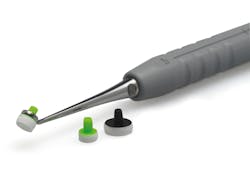Pearls for Your Practice: OptraSculpt Pad by Ivoclar Vivadent, HD Black Line Mirrors by Hu-Friedy, and Estelite Omega polychromatic composite by Tokuyama
OptraSculpt Pad by Ivoclar Vivadent
About a decade ago, I took an anterior composite course from legendary clinician Paul Belvedere, DDS. He taught a technique for shaping anterior composite with a dense foam cuticle pusher one might use while doing a manicure. I could never find the dense foam ones he used in any stores near me. I could only find wood ones, and they did not work the same way. After a few months of looking in stores (this was before ubiquitous Amazon), I gave up on these potential instruments and resolved to shape anterior composites with thin metal instruments. One day, a couple of years ago, I discovered a much more refined version of the cuticle pusher...the OptraSculpt Pad from Ivoclar Vivadent.
The pad attachments are one-time-use disposables. They come in refill kits of 60 each. The handle is fully autoclavable and has a great design to help you with your anterior dentistry. One of those design elements that helps is the front action and back action option. Your pad attachment can go on two different ways, which allows you to reach all the different angles you need for any anterior restoration. Another cool detail in the instrument handle is the esthetic reference scale built into the handle. This scale is super convenient to have right on the instrument handle and can help you create symmetrical anterior restorations. Having a handy and accessible built-in guide makes my life easier when working in the anterior.
I have never been able to sculpt anterior restorations with just a metal composite instrument. Having an adjunct that helps me build the flat planes that a good class IV restoration needs is important. Having an instrument that also has neat built-in details really makes the difference.
Dr. Paul Belvedere passed away a few years ago. I think he would have loved the OptraSculpt Pad and it would have been a staple in his composite setups. Triple to deep center field for the OptraSculpt Pad.
HD Black Line Mirrors by Hu-Friedy
More than 10 years ago, I was attempting to build my office from scratch. All the big things were on my mind. Real estate and my lease. Architecture and my office plans. Big equipment purchases and technology. All of these consumed my thoughts.
I realized that upping my instrument game would be a daunting process. I knew that replacing everything at the same time would be very costly. I decided to try to eat the elephant one bite at a time, starting with the most important bite, the one instrument we use more than any other—our mirrors. They are so essential, they have become part of the “clip art idea” of what dentists do. When I decided to replace my mirrors, I went to one of the best instrument makers in the country, Hu-Friedy. Their Black Line series of instruments had just what I needed, and the HD mirrors from that line are stunning.
The first thing you notice on the Hu-Friedy HD Black Line Mirrors is the cool black metal handles, which are DLC coated. DLC stands for diamond-like carbon, and this coating is known for its low friction, high hardness, and high corrosion resistance. According to the manufacturer, their durable matte black DLC coating helps to significantly reduce glare and gives excellent intraoral contrast. The HD mirrors themselves provide a high reflection factor, which gives exceptional image clarity, and they are much brighter than other common mirrors. Would you rather have a cheap instrument or a higher quality instrument that lasts years of your career? On something as important as my mirrors, I would rather have the latter.
Bad mirrors are like a disobedient dog. You don’t really know they are bad until you see a good one. That’s sort of how my mirrors were. I didn’t know how bad they were until I tried a HD Black Line mirror. That really opened my eyes—no pun intended. Line drive base hit to left field for Hu-Friedy!
Estelite Omega polychromatic composite by Tokuyama
When I was working on my mastership in the Academy of General Dentistry, I was doing a lot of hands-on continuing education. I enrolled in a “master track” program through the Texas Academy of General Dentistry. For our operative hours, we did a hands-on anterior composite course. The material that was used in the course was something I had never heard of before. It was called Estelite Omega, and I immediately thought, “This must be some kind of generic off-brand stuff.” About five minutes into the hands-on segment of the course, I realized how wrong I was. Playing with this stuff for just a few minutes opened my eyes to how amazing it was.
The shades included in the kit aren’t your traditional Vita shades. There are four enamel shades (EA1, EA2, EA3, and EB1), two effects shades (translucent and milky white), three dentin shades (DA1, DA2, DA3), and two bleach shades (BL1 and BL2). You will need to make a shade guide to help you make selections. That shade guide is included in the starter kits and takes around 20 minutes to make. That guide is vital to getting great esthetic matches, as are the tints. Included in the start kit is a DVD from the master himself, Newton Fahl Jr., DDS, MS. This clinical case guide will give you the resources you need to learn the Estelite Omega system from one of the world’s most talented humans.
Part of what sets Estelite Omega apart from the others is the spherical filler technology. These 200-nanometer spherical fillers are what give the exceptional shade blend to Estelite Omega. These are the same fillers that help make Omnichroma blend so well. In addition to shade blend, the spherical fillers offer an excellent level of polishability. Everyone who has tried Estelite Omega reveres the polish they can achieve with it.
Let’s just face it—anterior composites are different than posterior composites. More things matter on anterior teeth than do on posteriors. Those two things are shade blend and polishability. That is what sets Estelite Omega apart. Double into the right centerfield gap for Tokuyama!
Joshua Austin, DDS, MAGD, writes the Pearls for Your Practice column in Dental Economics. After graduating from the University of Texas Health Science Center Dental School, Dr. Austin associated for several years. In October of 2009, he opened a solo general practice in a suburban area of San Antonio, Texas. Dr. Austin is involved in all levels of organized dentistry and can be reached at [email protected].
About the Author
Joshua Austin, DDS, MAGD
Joshua Austin, DDS, MAGD, is a graduate and former faculty member of the University of Texas Health Science Center at San Antonio School of Dentistry. Author of Dental Economics’ Pearls for Your Practice column, Dr. Austin lectures nationally on products, dental technology, online reputation management, and social media. He maintains a full-time restorative dentistry private practice in San Antonio, Texas. You may contact Dr. Austin at [email protected].
Updated June 21, 2023




